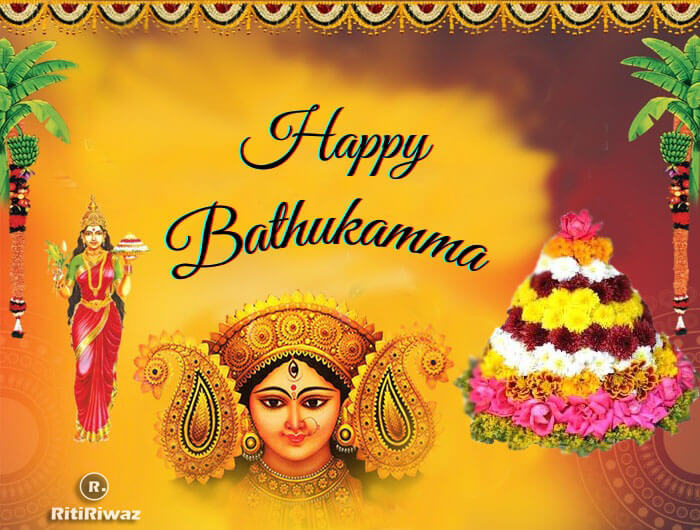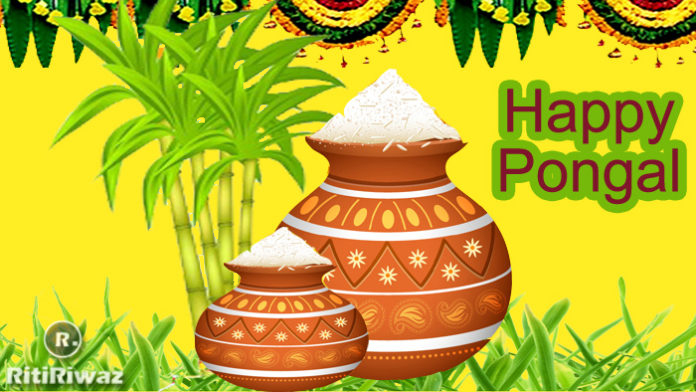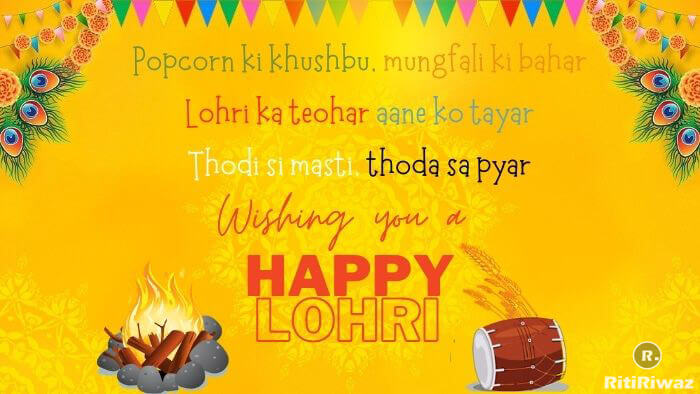Bathukamma Festival

Bathukamma is a floral festival of Telangana celebrated by the women during the culmination of the monsoon, just before the arrival of winter. Bathukamma, literally means goddess of life, a festival where women offer flowers to a goddess and seek her blessings. The government of Telangana state has declared the Bathukamma Festival as a Telangana state festival.
Bathukamma is celebrated during the nine days of Durga Navratri. The Duration of the festival varies depending on the local tradition. The festival begins on Mahalaya Amavasya and the last day of Bathukamma is on Durga Ashtami which is two days before Dussehra. As part of the festival, women prepare floral arrangements in conical shapes of seven layers as the embodiment of the goddess Gauri, the goddess of womanhood.
It is the festival for feminine felicitation. On this special occasion, women dress up in the traditional sari combining it with jewels and other accessories. Teenage Girls wear Langa-Oni/Half-Sarees/Lehenga Choli combining it with jewels in order to bring out the traditional grace of the attire.
Bathukamma is followed by Boddemma, which is a 7-day festival. Boddemma festival marks the ending of Varsha Ruthu whereas Bathukamma festival indicates the beginning of Sarad or Sharath Ruthu.
In 2025 the festival of Bathukamma begins on Monday, 22nd September.
Bathukamma is a beautiful flower stack, arranged with different unique seasonal flowers most of them with medicinal values. Flowers like Cassia, Celosia, Marigold, Chrysanthemum, Lotus, Cucurbita leaves, and others from uncultivated and barren plains of the region are used to decorate the Bathukamma. Which indicates the richness of life and tradition.
The festival is celebrated by women getting together, singing songs, and dancing around these wonderful flower arrangements called “Bathukamma”. At the end of the evening, nearing sunset, the flowers are set for sail in a river/creek and everyone exchanges their prasad. After playing around the “Batukammalu”, before the onset of dusk, the womenfolk carry them on their heads and go as a procession towards a bigger water lake of the village or town. The procession is extremely colorful with the decorations of women and the “Batukammalu”. “Batukammalu” are slowly immersed into the water after some more playing and singing.
Bathukamma represents the cultural spirit of Telangana. Batukamma is a great celebration of the preservation of nature’s harmony. The colorful flowers attractively arranged in tiers provide a visual feast besides purifying the air and water with their medicinal properties. Thus the festival is not a demonstration of pomp and show but intimately attached to nature. The inherent lesson the festival offers is to protect and preserve nature for the larger good of humanity.
History of Batukamma Festival
In the Chalukya kingdom of Vemulavaada (present-day Karimnagar District), the Rajarajeswara temple is popular. Rajarajeswara was worshipped by the Telangana people as their beloved deity. Raja Raja Chola ruled between 985-1014 AD. His son Rajendra Chola attacked Vemulavaada. He destroyed Rajeswara’s temple and took the Bruhat (huge) Siva linga to his father as a gift which was subsequently established in the Brihadeswara temple that he built.
The loss of the Linga dejected the people of Telangana. Considering that Lord Shiva left them (in the form of the Linga) and in symbolism to comfort Goddess Parvathi (Bruhadamma) who loves flowers. An array of flowers arranged like the Meru mountain, on top of which Gouramma made with turmeric paste was placed and with song and dance, the loss is recounted. Finally dispatching the flowers (symbolizing Parvati) in the water, the people begged her to return to them again. This ritual over time took the shape of a festival, that has been observed since.
The ritual
On the first five days of the nine-day festival, women clean their courtyards and smear cow dung mixed with water as a paste all over the area. Rangolis or Muggu patterns are drawn with rice flour. All five days cow dung is used to prepare the Bathukamma, usually in a cone shape and arranged in the courtyard.
Men of the house gather flowers from the wild plains like Celosia, Senna, Marigold, Chrysanthemum, Indian Lotus, Cucurbita leaves & flowers, Cucumis Sativus leaves & flowers, Memecylon edule, Tridax procumbens, Trachyspermum ammi, Katla, Teku Flowers, etc. These flowers bloom in this season in various vibrant colors all across the uncultivated and barren plains of the region.
For nine days, young girls and other female folk gather in their respective localities with their Bathukammas, form a circle, and sing songs and dance revolving around the bathukamma in the center. Women seek the blessings of the Goddess for the well-being and prosperity of their families through the songs that are sung. By tradition, any of the tributes of Uyyala (Swing), Chandamama (Moon), or Gouramma (the Goddess) end the rendition.
Each day has a name mainly signifying the type of “naivedyam” (food offering) offered. Most of the naivedyam (food offering) offered are very simple to prepare, and usually, young children or young girls are mainly involved in the preparation of the offerings for the first eight days of the festival. The last day, called Saddula Bathukamma is when all the women take part in the preparation.
On Saddula Bathukamma or Pedha Bathukamma, this final day immersion of Bathukamma (Bathukamma Visarjan) in water bodies is celebrated with utmost devotion and enthusiasm with rhythmic drum beats throughout Telangana. Gouramma (a symbolic idol of Gowri made of turmeric) is taken back from Bathukamma before immersion. Every married woman applies a paste of this, on her Mangala sutra that marks the solemnization of her marriage, and also her husband is protected from all evils and ill fate.






